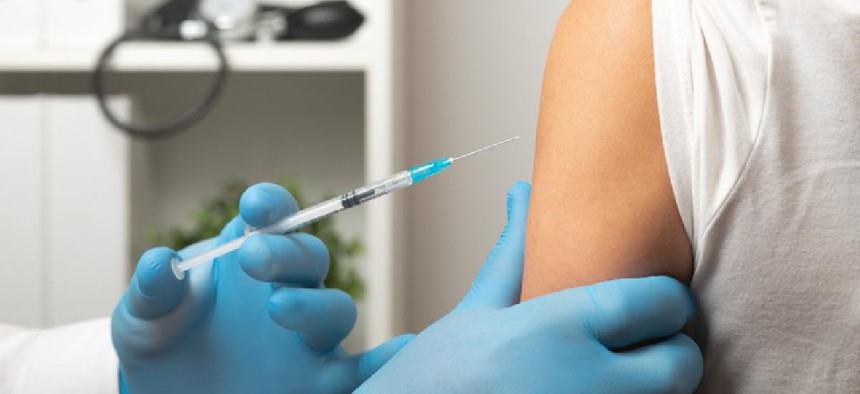VA vaccine distribution will require 'Herculean effort,' says VA official

The agency is preparing to receive initial shipments of vaccines, but getting it to rural areas of the country will be a challenge.

COVID-19 vaccinations at the Department of Veterans Affairs will be a "long process," said a senior agency official in testimony at a Senate Committee on Veterans Affairs hearing on Dec. 9.
The agency is set to receive an initial 73,000 doses of the Pfizer vaccine, but it anticipates that 7 million veterans will want a vaccination via the agency, along with the 400,000 VA employees, said Richard Stone, executive in charge at Veterans Health Administration.
This initial batch of vaccines "is not an adequate amount," and distributing vaccines to rural areas and maintaining staffing levels are obstacles that will require "Herculean effort," Stone said.
The VA will receive initial doses of the Pfizer vaccine after the vaccine receives an Emergency Use Authorization from the Food and Drug Administration, which Stone said is anticipated in the coming days. The agency has also requested over 120,000 doses of the Moderna vaccine.
The agency released its initial plans for the vaccine rollout on Dec. 10. It has coordinated in planning with the Centers for Disease Control and Operation Warp Speed, the Trump administration's vaccine development project.
VA health care workers and veterans in long-term care units are at the front of the line to receive vaccinations.
"As vaccine supplies increase, additional Veterans will receive vaccinations based on factors such as age, existing health problems and other considerations that increase the risk of severe illness or death from COVID-19," the agency said.
Particularities about the Pfizer vaccine, particularly the need for it to be stored at negative 70 degrees Fahrenheit, are playing a large role in the distribution planning. Once the vaccine is unfrozen and prepared, it also has to be delivered within a certain timeframe.
The VA has 37 sites prepared to receive the Pfizer vaccine. These initial distribution sites were chosen based on their ability to store the vaccine at cold temperatures and "matched to the concentration of veterans in that area," Stone said.
This strategy is known as the hub and spoke model, where vaccine doses are stored in a central location and then distributed out. Secondary shipment beyond those sites is dependent on regulations for moving the vaccine, which the CDC has not yet released, Stone said.
The agency will also be receiving 36 additional freezers to aid in the Pfizer vaccine distribution. Stone said that their location will be determined in the coming weeks. The VA has also executed 83 contracts for dry ice to aid in vaccine distribution.
The VA has also been preparing sites to accept doses of the Moderna vaccine, which also does not yet have FDA approval. The agency currently has 188 sites to initially accept the Moderna vaccine, Stone said. It does not require the same low storage temperatures as the Pfizer vaccine.
A large obstacle to vaccine distribution will be getting the vaccines to rural areas, given their specific storage requirements. Stone told the senators that he's had conversations about the potential use of short runway aircraft to deliver small amounts of the vaccine to rural areas, and he said that "creativity and innovation" will be required to complete the task.
"We are going to have some difficulties reaching rural areas, but you have our commitment that we will work diligently until every veteran is delivered this vaccine and we assure the safety of the population that is enrolled with us," he said.
Both vaccines require a second round of vaccination a certain number of days after the initial injection, a condition that will entail careful tracking to ensure that VA employees and veterans receive both doses at the correct intervals, Stone said.
The 37 initial distribution sites will also be monitoring those who receive the vaccine for side effects using the VA's existing vaccine monitoring and tracking system already used for vaccine monitoring.
Stone pointed to weaknesses in the sustainment of medical workforce in both private hospitals and those within the VA. The waiving of administrative hiring requirements by the Office of Personnel Management have been critical in hiring over 66,000 new VA employees, he said. It would be difficult to sustain the workforce if those hiring abilities were to be taken away, he said.
Since the onset of the pandemic, agency employees and unions have complained about unsafe working conditions in the agency. The American Federation of Government Employees said that these problems remain in a statement supplied to the committee.
"With few exceptions, management policies and practices for Personnel Protective Equipment (PPE), leave, staffing, telework, testing, and hazard and incentive pay, have been unpredictable, uneven, and arbitrary," the statement said.
Finally, the VA has the capability to help private hospitals experiencing medical staff shortages under its "fourth mission" of preparing the nation for emergencies, wars and other disasters, Stone said. VA officials have been in contact with state governors about their ability to support private hospitals with services, personnel, consultation and the provision of personnel protective equipment.
The VA is able to take in critically ill patients via transfer, Stone said. It presently has 1,100 intensive care unit beds available, and the agency has mobile units it can move to areas that are particularly hard hit.
NEXT STORY: Developing an agency brand to modernize HR






